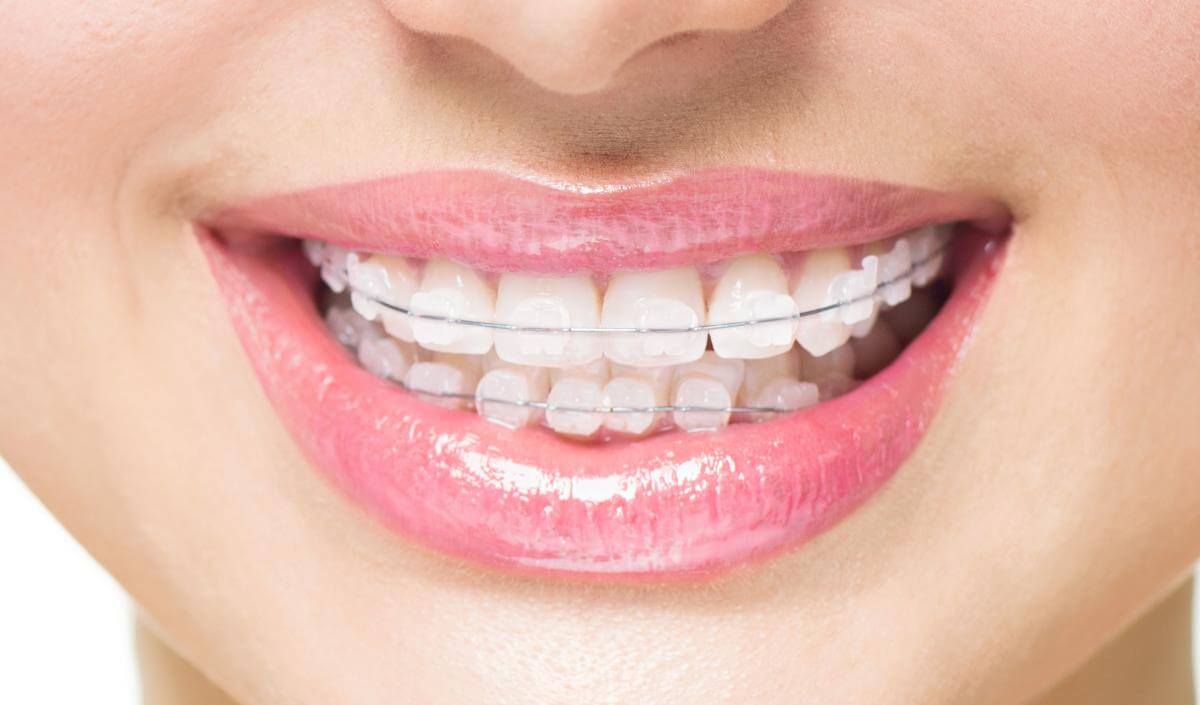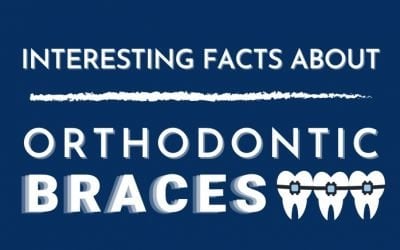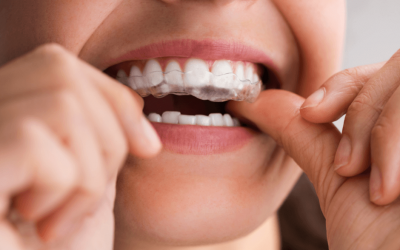Ceramic Braces: Ancient Origins, Bright Future?

What exactly is ceramic? Essential to daily life and classified as inorganic and non-metallic materials, archeologists have uncovered ceramics dating back to at least 24,000 BC.
Found in Czechoslovakia were ceramic animal and human figurines, slabs, and balls made from animal fat and bone, mixed with bone ash and a fine claylike material. After shaping, the ceramics were fired at temperatures between 500-800°C in horseshoe-shaped, domed kilns that were partially dug into the ground and had walls of loess: a clastic, predominantly silt-sized sediment that forms from wind-blown dust. Because the abundance of silt particles ensures fine soil with good aeration, water retention, seedbed production and easy cultivation, loess are among the most fertile earth on earth. Ten percent of the word’s landmass consists of loess or similar sediment.
This Palaeolithic settlement of Dolní Věstonice in Moravia, (then Czechoslovakia, now) Czech Republic, has been under systematic archaeological research since 1924.
In addition to the animal figurines – a bear, a lion, a mammoth, a horse, a fox, a rhino and an owl – were more than 2,000 balls of burnt clay, and a female figurine. Aptly named Venus of Dolní Věstonice it stands 111 millimetres (4.4 inches) tall, and 43 millimetres (1.7 inches) at its widest; made of clay fired at a relatively low temperature. It was discovered on July 13, 1925 in a layer of ash, broken into two pieces. Once on display at the Moravian Museum in Brno, it is now a protected piece rarely accessible to the public, with scientists still periodically examining the statuette.
A 2004 tomograph found the fingerprint of a child – estimated to be between 7 and 15 years of age – fired into the surface of the piece; although a child handling the figurine before it was kilned is considered an unlikely candidate for its maker.
While it’s not clear what these first-found ceramics were used for, it’s not considered to have been utilitarian. Functional pottery vessels found in Asia are thought to have not existed before 9,000 BC; used to hold and store grain as well as other foods. The difference between ceramics and pottery is that pottery is made of only clay, while ceramics are made of clay and other material, including glazes.
Ceramic baby bottles from thousands of years ago have been unearthed from the graves of children and would not look completely out of place in a baby’s room today. Some have little feet; one spout is a tail. These Bronze and Iron Age vessels smack of whimsy but they, like other everyday items for eating and food preparation, provide scientists with an unprecedented view of how people ate long ago.
For example, seeped into the pores of three ceramic bottles from Bavaria, a 2019 examination of these fatty lipids suggests that between 1200 BC and 450 BC mothers were supplementing childrens’ diets or weaning them with animal milk. It’s speculated that the inspiration for the bottles may have been to amuse their children. That they make us laugh today gives such a connection to the past; to which we all aspire in our more nostalgic moments.
The properties of ceramic materials, like all materials, are dictated by the types of atoms present, the types of bonding between the atoms, and the way the atoms are packed together. This is known as the atomic scale structure. Most ceramics are made up of two or more elements, called a compound.
The atoms in ceramic materials are held together by a chemical bond – the two most common being covalent and ionic. For metals, this bond is called the metallic bond and the reason metals are ductile and ceramics brittle, is because covalent and ionic bonding are much stronger than metallic.
Ceramic is a highly useful material today because of its properties. It is hard, wear-resistant, refractory, thermally and electrically insulating, nonmagnetic, oxidation resistant, prone to thermal shock (able to withstand wide temperature variations) and it’s chemically stable.
All of this is what allows the multitude of applications on which we have for so long relied.
Ancient glass manufacturing is thought to be closely related to pottery making, which flourished in Upper Egypt about 8,000 BC. The presence of calcium oxide and sand in the process of firing pottery, combined with soda and the overheating of the kiln may have resulted in a coloured glaze. Experts believe that it was not until 1,500 BC that glass was produced independently of ceramics.
Ceramics are all around. It’s a category of material includes tiles, teeth, bricks, plates, glass and toilets. Watches, snow skis, cars and phone lines contain ceramics. Because it can be dense or lightweight it’s in space shuttles and aeroplanes. Some ceramics, like superconductors, display magnetic properties.
Ancient Egypt is the earliest civilisation to have practised using a form of orthodontic braces with many archaeological digs identifying braces on mummified remains. It was a popular tradition to have metal wires wrapped around the teeth that would be tightened to pull them into place. It’s thought that braces like this were used to improve the aesthetics of high ranking and respected individuals during burial, not during their lifetime, as later done by a Roman encyclopaedist.
Aulus Cornelius Celsus theorised that teeth could be pressured and forced into a different position, and widely derided. He practised his hypothesis, developed palate expanders and recorded his findings. Thus began the journey of modern orthodontics.
Ceramic braces entered orthodontics via an indirect route. Translucent polycrystalline alumina (TPA) was developed by NASA (National Aeronautics and Space Administration) and Ceradyne, a leader in advanced ceramics for aerospace, defence, electronics, and industrial use. In 1986, a dental equipment and supply company contacted Ceradyne for an aesthetic material to be used in orthodontics. Ceradyne recommended TPA. Shortly, after this contact, namely in 1987, ceramic brackets were introduced. In the same year, i.e., 1987, the production of ceramic braces reached 300,000 pieces a month. 300,000 pieces would translate into 15,000 non-extraction patients per month. Ceramic braces have progressed substantially since their first introduction over 30 years ago.
Ceramic braces can be more comfortable than metal because they don’t irritate the inside of the mouth as much. They are however, less durable than stainless steel. Studies have found that ceramic braces are more than twice as likely as metal ones to break off or fracture.
Like any compromise, this simply makes care and compliance of your ceramic braces extremely important. It doesn’t mean you can’t or shouldn’t have them – the advantage of clear or tooth-coloured brackets may suit you and your lifestyle much better than metal in the treatment you opt to have.

10 Advantages of Ceramic Braces
There’s a great article by Blue Ridge Orthdontics which goes into greater depth on this list of ten advantages to ceramic braces.
1) Ceramic Braces Are More Discreet Than Traditional Braces
2) Ceramic Braces Are Tougher Than They Sound!
3) The Arch Wire can be “Coloured” to Blend with Your Teeth
4) Ceramic Braces Don’t Demineralise Tooth Enamel
5) Clear Ceramic Braces Are Easy to Remove (After Treatment Finishes)
6) Ceramic Braces Won’t Be Noticeable in Pictures
7) Ceramic Braces Can Work Faster Than Invisalign
8) Ceramic Braces Are More Comfortable Than Traditional Metal Braces
9) The Latest Ceramic Braces Don’t Stain As Easily
10) Younger Patients Can Add Flair with Coloured Bands
What Are the Disadvantages to Ceramic Braces?
Finally, ceramic braces require more maintenance than metal braces if you want to keep them looking pristine. Since the material itself is clear and porous, there is the opportunity for it to stain if the highest level of oral hygiene is not maintained.
From ancient times, ceramics have ensured and impelled a brightness in our future.
You can bring that to your smile.
DISCLAIMER:
The content has been made available for informational and educational purposes only. Central Coast Orthodontics does not make any representation or warranties with respect to the accuracy, applicability, fitness, or completeness of the content.
The content is not intended to be a substitute for professional personal diagnosis or treatment. Always seek the advice of your dentist or another qualified health provider with any questions you may have regarding a dental or medical condition. Never disregard professional advice or delay seeking it because of something you have read or seen on the Site.
Learn More About
Related Articles
Interesting Facts About Orthodontic Braces
Wanting to get orthodontic braces but feeling unsure because you don't have knowledge about its...
Three Benefits of Invisalign
Did you know that aside from being an option for straightening your teeth, there are also benefits...
Metal Braces: Does This Traditional Dental Technology Have a Future?
Of all the medical professions, dentistry has always generated the most fear and continues to;...
Can Children Have Clear Aligner Treatment?
When it comes to orthodontic treatment, patients are spoiled for choice. While traditional braces are still the most common form of correct…






